Related compounds Molar mass 282.4614 g/mol Boiling point 360 °C | Formula C18H34O2 Density 895 kg/m³ | |
 | ||
Appearance Pale yellow or brownish yellow oily liquid with lard-like odor | ||
Oleic acid chemistry
Oleic acid is a fatty acid that occurs naturally in various animal and vegetable fats and oils. It is an odorless, colorless oil, although commercial samples may be yellowish. In chemical terms, oleic acid is classified as a monounsaturated omega-9 fatty acid, abbreviated with a lipid number of 18:1 cis-9. It has the formula CH3(CH2)7CH=CH(CH2)7COOH. The term "oleic" means related to, or derived from, olive oil which is predominantly composed of oleic acid. The corresponding stereoisomer trans-9-Octadecenoic acid is called Elaidic acid. These isomers have distinct physical properties and biochemical properties. Elaidic acid, the most abundant trans fatty acid in diet, appears to have an adverse effect on health.
Contents
- Oleic acid chemistry
- Occurrence
- As an insect pheromone
- Production and chemical behavior
- Uses
- Health effects
- References
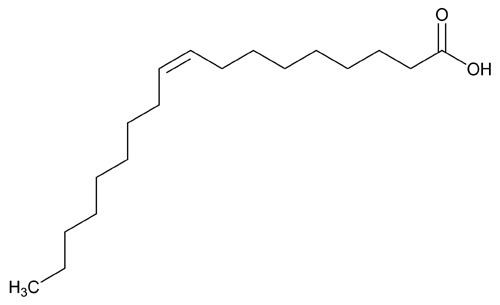
Occurrence

Fatty acids (or their salts) do not often occur as such in biological systems. Instead fatty acids like oleic acid occur as their esters, commonly triglycerides, which are the greasy materials in many natural oils. Fatty acids can be obtained via the process of saponification.

Triglycerides of oleic acid compose the majority of olive oil, although there may be less than 2.0% as free acid in virgin olive oil, with higher concentrations making the olive oil inedible. It also makes up 59-75% of pecan oil, 61% of canola oil, 36-67% of peanut oil, 60% of macadamia oil, 20-85% of sunflower oil (the latter in the high oleic variant), 15-20% of grape seed oil, sea buckthorn oil, and sesame oil, and 14% of poppyseed oil. It is abundantly present in many animal fats, constituting 37 to 56% of chicken and turkey fat and 44 to 47% of lard.
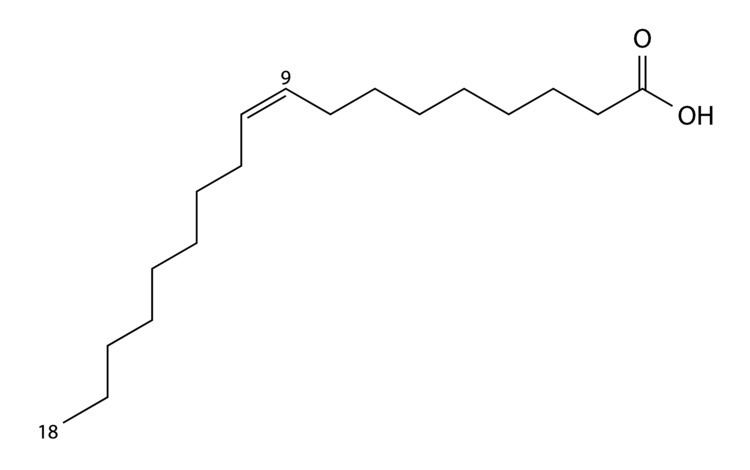
Oleic acid is the most abundant fatty acid in human adipose tissue, and second in abundance in human tissues overall only to palmitic acid.
As an insect pheromone
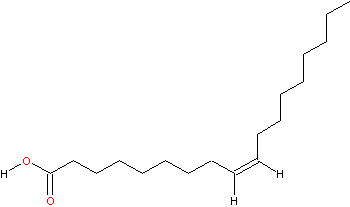
Oleic acid is emitted by the decaying corpses of a number of insects, including bees and Pogonomyrmex ants, and triggers the instincts of living workers to remove the dead bodies from the hive. If a live bee or ant is daubed with oleic acid, it is dragged off for disposal as if it were dead. The oleic acid smell also may indicate danger to living insects, prompting them to avoid others who have succumbed to disease or places where predators lurk.
Production and chemical behavior

The biosynthesis of oleic acid involves the action of the enzyme stearoyl-CoA 9-desaturase acting on stearoyl-CoA. In effect, stearic acid is dehydrogenated to give the monounsaturated derivative oleic acid.
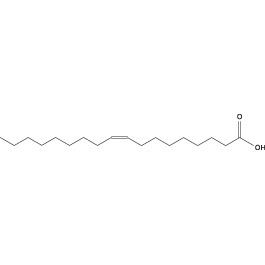
Oleic acid undergoes the reactions of carboxylic acids and alkenes. It is soluble in aqueous base to give soaps called oleates. Iodine adds across the double bond. Hydrogenation of the double bond yields the saturated derivative stearic acid. Oxidation at the double bond occurs slowly in air, and is known as rancidification in foodstuffs or drying in coatings. Reduction of the carboxylic acid group yields oleyl alcohol. Ozonolysis of oleic acid is an important route to azelaic acid. The coproduct is nonanoic acid:
H17C8CH=CHC7H14CO2H + 4"O" → H17C8CO2H + HO2CC7H14CO2HEsters of azelaic acid find applications in lubrication and plasticizers.
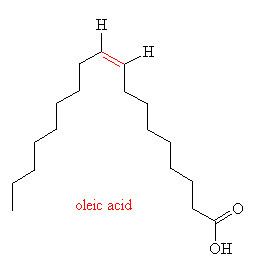
The trans isomer of oleic acid is called elaidic acid (hence the name elaidinization for a reaction that converts oleic acid to elaidic acid).
A naturally occurring isomer of oleic acid is petroselinic acid.
In chemical analysis, fatty acids are separated by gas chromatography of methyl esters; additionally, a separation of unsaturated isomers is possible by argentation thin-layer chromatography.
Uses
Oleic acid (in triglyceride form) is included in the normal human diet as a part of animal fats and vegetable oils.
Oleic acid as its sodium salt is a major component of soap as an emulsifying agent. It is also used as an emollient. Small amounts of oleic acid are used as an excipient in pharmaceuticals, and it is used as an emulsifying or solubilizing agent in aerosol products.
Oleic acid is also used to induce lung damage in certain types of animals, for the purpose of testing new drugs and other means to treat lung diseases. Specifically in sheep, intravenous administration of oleic acid causes acute lung injury with corresponding pulmonary edema. This sort of research has been of particular benefit to premature newborns, for whom treatment for underdeveloped lungs (and associated complications) is often a matter of life and death.
Oleic acid is used as a soldering flux in stained glass work for joining lead came.
Health effects
Oleic acid is a common monounsaturated fat in human diet. Monounsaturated fat consumption has been associated with decreased low-density lipoprotein (LDL) cholesterol, and possibly increased high-density lipoprotein (HDL) cholesterol. However, its ability to raise HDL is still debated.
Oleic acid may be responsible for the hypotensive (blood pressure reducing) effects of olive oil. Adverse effects also have been documented, however, since both oleic and monounsaturated fatty acid levels in the membranes of red blood cells have been associated with increased risk of breast cancer, although the consumption of oleate in olive oil has been associated with a decreased risk of breast cancer.
